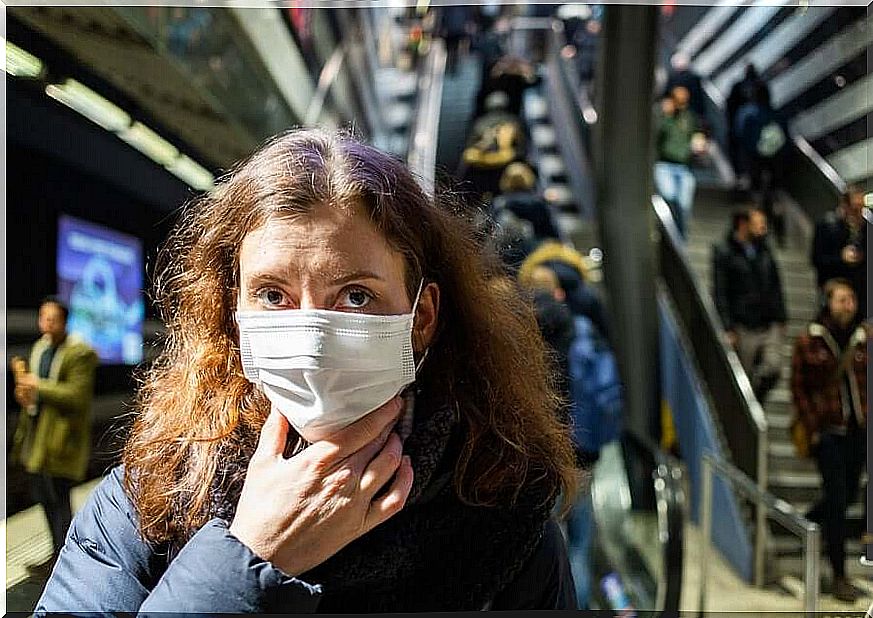What Is A Super Contaminator?
A super contaminator is a sick person with the capacity to transmit the disease to many people. Find out here how it is done and what are the implications of this phenomenon in these times of pandemic.

The coronavirus pandemic (COVID-19) continues to be a part of our lives. In this context, we are forced to familiarize ourselves with the new medical terms that the media are employing. From detection tests to numbers, rates, predictions and statistics, we receive a large amount of epidemiological information. We just recently discovered a new term, the term super-contaminator.
What does this term mean? What is the role of a super-contaminator in this pandemic context? The answers to these questions allow us to understand how a super contaminator contributes to the spread of the virus. That is why, in this article, we explain to you what this term means.
What is a super-contaminator?
The term super-contaminator refers to a sick person capable of infecting more people than the average person infected. Let’s take a look at an example.
- According to the World Health Organization (WHO), the R0 (basic reproductive rate) value of the coronavirus is between 1.4 and 2.5. This means that each infected patient will infect on average more than one person, but less than three people during the illness.
- The Ro value of the SARS virus was close to three: during the epidemic, researchers found that super-contaminators were able to infect up to 36 people. This means that the overall reproductive rate of the disease was 10 times greater in these people than in “normal” patients.
- At the start of the COVID-19 pandemic, cases of super-contaminants were recorded in the city of Wuhan in China: one of them had transmitted the disease to at least 16 health professionals
- In the rest of the world, there have been other similar cases. In New York, for example, a judge transmitted the disease to at least 20 people
It is clear that the basic reproductive rate represents an average, and that the individual reproductive rate of super-contaminators is disproportionate compared to the average rate. Now that you know what a super-contaminator is, it is now time to understand the importance of this finding in this time of a pandemic.

A statistical game
Like all natural processes, it is mathematical theorems that govern the importance of these topics. It is necessary to enter the world of numbers with the Pareto principle. This theorem describes the following statistical phenomenon: within a population that contributes to a common effect, only a small proportion contributes to the major part of the effect.
In other words, it’s the 20/80 rule: 20% of sick people are responsible for 80% of infections. Some cases of super-contaminants cannot be associated with this general rule, but this phenomenon has already been observed in other epidemics. The transmission of the coronavirus by super contaminators is still important even if it does not follow the 20/80 rule. Why are some patients with COVID-19 super contaminants?
Supercontaminator: the risk factors
There are different theories about how a patient can infect an inordinate number of people. But we do not know what is the real cause behind this finding:
- Co-infection with other pathogens: the coexistence of several pathogens in our body can promote greater transmissibility of one or more of them to other people. Some studies have shown that patients with HIV or with secondary disease developed the disease more than those without co-infection.
- Weakened immune system : A weakened immune system may not be able to effectively stop the spread of a virus in the body. Consequence of this: the viral load increases. Above average viral load is associated with greater transmission capacity
- Strong immune system: A sick person’s immune system may be so ready to face an infection that it doesn’t even realize it is infected. Because of this, he continues to lead his normal life while transmitting the virus to many people.

An interesting study
The results of this study published in the journal Synapse are interesting for this topic. During the SARS pandemic, cases of super-contaminating patients and normal patients were recorded. Contrary to what one might think, there were no differences in clinical symptomatology between the two groups.
Both super-contaminants and normal patients presented the same symptoms. Namely fever and lung damage. The only small difference observed was the following: the super-contaminants had to stay longer in the hospital to overcome the disease.
A term still very enigmatic
Both the identification and the role of a super-contaminator during a pandemic are parameters that are difficult to discern. However, some specialized organizations emphasize the importance of identifying these people. And this in order to avoid the increase in the number of infected people in this time of pandemic.









